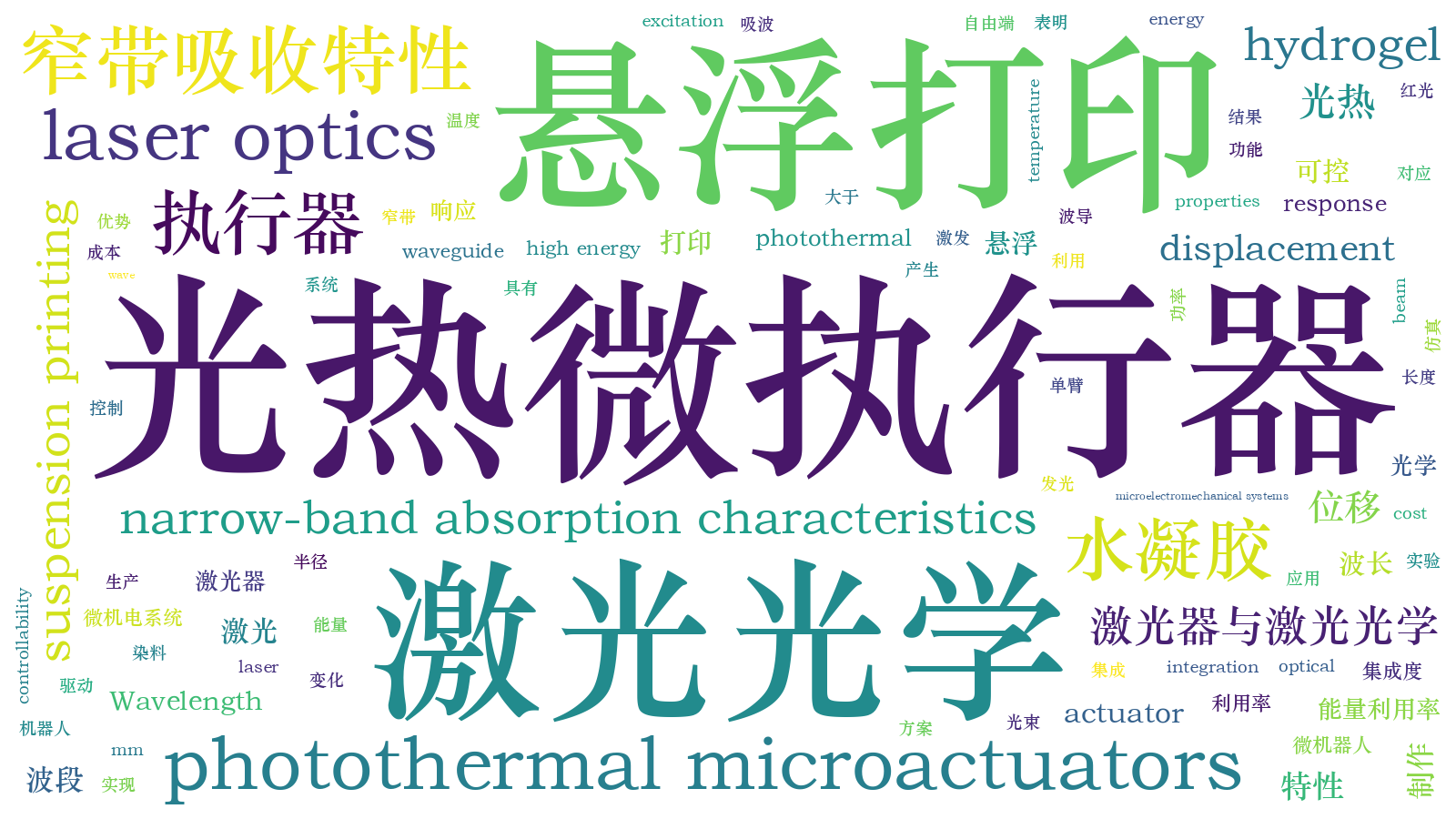悬浮打印的波长可控光热微执行器及其特性  下载: 532次
下载: 532次
1 引言
光热微执行器作为微机电系统(MEMS)的重要分支,能将光能转化为机械能,进而激发较大的应变,且具有非接触、抗干扰特性,在生物医学领域常被作为微夹持[1]和微开关[2],在人工智能领域多被应用于微型机器人的执行模块[3]。传统的光热微执行器通常依靠空间激光束给加热执行部位赋能,这种方式难以制作紧凑的结构,而光波导结构比传统方式更加高效集成[4],且光导激发方式对外部的光照条件没有约束,因此,可以使用光波导或光纤[5]制作结构紧凑的光热微执行器。
广泛应用于光热微执行器中的工艺有高纵横比光刻工艺、软光刻工艺等,如:Wang等[6]利用高纵横比光刻工艺制作了红外光驱动的金属镍光热V型执行器;Elbuken等[7]凭借软光刻工艺制备了单层聚合物(SU-8)的光热驱动微夹持器,可实现电隔离,且具有重复性高、夹持过程柔和的优点。近年来,三维打印技术凭借低成本、设计制造流程迭代快的优点在组织结构制作中引起了人们的广泛关注,如:Patrício等[8]用黄原胶(XG)作为打印基质打印生物组织结构;Takishima等[9]利用三维打印水凝胶执行器作为水母型软体机器人移动模块。
本文提出了一种基于三维嵌入式打印且受单一波长光束控制的光热微执行器制造方案。用卡波姆水凝胶作为三维打印的支撑,用于稳固打印后光热微执行器的结构。水凝胶的非牛顿特性使打印的紫外(UV)固化树脂有着较大的表面能差异[10],打印结构能在打印和固化后均保持良好的形态。用功能性染料作为光热转换介质材料以平衡制作难度和材料稳定性,实现U型光热微执行器的制作[11]。在相同结构的光热微执行器制作方案下,该方案能适应不同的控制光源,也可作为并行控制的替代方案,在微型机器人中实现更高的自由度[12]、在生物医学中实现更高的精度[13]。最终制备的光热微执行器分别被紫光(408 nm)和红光(638 nm)以光导形式激发,通过实验研究了热转化动态过程和温度分布,同时讨论了不同波长激光下光热微执行器的位移。
2 光热微执行器的设计与制备
2.1 设计
光热微执行器的光波长可控方案验证模型为U型光热微执行器,其几何参数和打印液NOA61树脂材料的参数如
表 1. 光热微执行器的材料参数和结构尺寸
Table 1. Material parameters and structural dimensions of photothermal microactuator
|
2.2 仿真结构
在忽略热膨胀引起的结构变形条件下计算焦耳热,同时设定U型光热微执行器的外界恒温条件和单端固定的边界条件。当光束通过光热微执行器内部时,该光热微执行器的涂层表面被激光逐渐加热升温。之后在固定臂表面设定一个厚度为5 µm的薄层加热区域,模拟光热转化情形。仿真设置的初始条件:外界平均室温为20 °C;达到稳定状态后光热微执行器固定端的最高温度达到59.6 °C。用5 mW热源加热光热微执行器固定臂后,光热微执行器温度达到了稳定状态,如
2.3 光热转换材料的选择
为了对光热微执行器进行独立控制,PTC材料的要求是能在窄波段吸收更多的光波,且不同材料的吸收波段互异。碳纳米管(CNTs)[14-15]和液晶聚合物(LCPs)[4-5,16]作为光热转换介质吸收激光能量,之后转化为驱动部位的温度变化以产生应变,实现机械运动,吸收光谱较宽(大于300 nm)[17-19]。近年来,为了实现高精度和并行控制,许多研究用纳米颗粒(NPs)进行光热转换[20-21],如Sutton等[22]设计的细胞微操作平台利用金纳米棒(AuNR)对近红外光(NIR)的窄带吸收特性,但成本昂贵。实验用光谱分析仪和卤素灯测试分析了五种功能性染料的吸收光谱,结果如
2.4 制备方法
光热微执行器的制备过程如

图 4. 方形螺旋传动臂的制造过程。(a)水凝胶印刷;(b)UV光束固化;(c)功能性染料溶液的涂敷
Fig. 4. Fabrication process for the square-spiral actuating arm. (a) Hydrogel printing; (b) UV beam curing; (c) coating of functional dye solutions
3 分析与讨论

图 5. 水凝胶支撑打印的光热微执行器。(a)光热微执行器;(b)固定在固化树脂支撑板上的光热微执行器;(c)执行驱动臂的显微图像;(d)悬臂梁自由端的输出
Fig. 5. Photothermal microactuator printed by hydrogel support. (a) Photothermal microactuator; (b) photothermal microactuator fixed on a cured resin support plate; (c) microscopic image of the actuation drive arm; (d) output from the free end of the cantilever beam
温度变化是光热应变的重要特性之一,热成像相机拍摄的红外图像可以很好地反映光热微执行器驱动臂在光功率固定、单一波长光束下的温度变化情况。NOA61树脂的低热导率(0.16 W/(m·K))会使热量集中在热转换区域。借助热成像相机配套的热分析软件AnalyzeIR读取数据可得到温度和照射时间的关系曲线。激光输入会导致执行器热转换区域产生不同程度的温度变化,这取决于涂附的窄带吸波材料。为了方便论述,将涂有灿烂黄的样品称为Ⅰ型样品,涂有亚甲基蓝的样品称为Ⅱ型样品。

图 6. 热成像相机下光热微执行器的初始状态。(a)Ⅰ型光热微执行器;(b)Ⅱ型光热微执行器
Fig. 6. Initial state of the photothermal microactuator under the thermal imaging camera. (a) Type I photothermal microactuator; (b) type II photothermal microactuator
上臂(驱动臂)的平均温度在开启功率为100 mW的单波长激光后(0~360 s)约为21.0 ℃,撤掉激光后(360~480 s)温度增大了约37.5%,如

图 7. 执行器温度随时间的变化曲线。(a)638 nm激光;(b)405 nm激光
Fig. 7. Variation curve of actuator temperature with time. (a) 638 nm laser; (b) 405 nm laser

图 8. 激光驱动下执行器的状态。(a)Ⅰ型执行器的初始状态(0 mW);(b)Ⅰ型执行器的应变状态(100 mW);(c)Ⅱ型执行器的初始状态(0 mW);(d)Ⅱ型执行器的应变状态(100 mW)
Fig. 8. State of the actuator driven by the laser. (a) Initial state of type Ⅰ actuator (0 mW); (b) strain state of type Ⅰ actuator (100 mW); (c) initial state of type Ⅱ actuator (0 mW); (d) strain state of type Ⅱ actuator (100 mW)

图 9. 执行器位移随时间的变化曲线。(a)408 nm激光;(b)638 nm激光
Fig. 9. Variation curve of actuator displacement with time. (a) 408 nm laser; (b) 638 nm laser
4 结论
将水凝胶支撑打印的聚合物光热微执行器与功能染料的窄带吸波特性相结合制备出由紫光(408 nm)和红光(638 nm)以光导形式控制的光热微执行器。测试结果表明,两种波长的光都能有效激发相应光热微执行器自由端的位移,在激光功率为100 mW的情况下,紫光能激发光热微执行器实现160 μm的末端执行部位位移,红光能激发光热微执行器实现101 μm的位移,光热微执行器驱动臂的最高平均温度可达48.1 ℃,最高峰值温度接近60.0 ℃,而非对应激光下自由端的位移小于25 μm,这表明功能染料能有效吸收对应波长的激光。该研究可进一步发展为微型机器人的智能抓取装置和机械执行装置或在柔性光电器件[25-26]中使用的光热微执行器。
[1] Maitland D J, Metzger M F, Schumann D, et al. Photothermal properties of shape memory polymer micro-actuators for treating stroke[J]. Lasers in Surgery and Medicine, 2002, 30(1): 1-11.
[2] Hiremath S, Shrishail M H, Kulkarni S M. Progression and characterization of polydimethylsiloxane-carbon black nanocomposites for photothermal actuator applications[J]. Sensors and Actuators A: Physical, 2021, 319: 112522.
[3] Miskin M Z, Cortese A J, Dorsey K, et al. Electronically integrated, mass-manufactured, microscopic robots[J]. Nature, 2020, 584(7822): 557-561.
[4] Chollet F. Devices based on co-integrated MEMS actuators and optical waveguide: a review[J]. Micromachines, 2016, 7(2): 18.
[5] Li R Z, Yu Y, Zhang X Y, et al. Integrated optical readout using a hybrid plasmonic directional coupler in water[J]. Applied Optics, 2017, 56(25): 7230-7236.
[6] Wang B, Shi B, Yi F T, et al. Photothermal microactuators fabricated by LIGA technology[J]. Key Engineering Materials, 2013, 562/563/564/565: 534-537.
[7] Elbuken C, Gui L, Ren C L, et al. Design and analysis of a polymeric photo-thermal microactuator[J]. Sensors and Actuators A: Physical, 2008, 147(1): 292-299.
[8] Patrício S G, Sousa L R, Correia T R, et al. Freeform 3D printing using a continuous viscoelastic supporting matrix[J]. Biofabrication, 2020, 12(3): 035017.
[9] Takishima Y, Yoshida K, Khosla A, et al. Fully 3D-printed hydrogel actuator for jellyfish soft robots[J]. ECS Journal of Solid State Science and Technology, 2021, 10(3): 037002.
[10] Yao J N, Li R Z, Fang Y M, et al. Three-dimensional printing in hydrogel for a complex waveguiding photothermal microactuator[J]. OSA Continuum, 2021, 4(5): 1555-1563.
[11] Cheng W, Zhang J, Liu J, et al. Granular hydrogels for 3D bioprinting applications[J]. View, 2020, 1(3): 20200060.
[12] ChoK J, AsadaH. Multi-axis SMA actuator array for driving anthropomorphic robot hand[C]∥Proceedings of the 2005 IEEE International Conference on Robotics and Automation, April 18-22, 2005, Barcelona, Spain. New York: IEEE Press, 2005: 1356-1361.
[13] Peters C, Ergeneman O, García P D W, et al. Superparamagnetic twist-type actuators with shape-independent magnetic properties and surface functionalization for advanced biomedical applications[J]. Advanced Functional Materials, 2014, 24(33): 5269-5276.
[14] Zhao G, Sun Z Z, Wang J, et al. Development of biocompatible polymer actuator consisting of biopolymer chitosan, carbon nanotubes, and an ionic liquid[J]. Polymer Composites, 2017, 38(8): 1609-1615.
[15] Zhang X B, Pint C L, Lee M H, et al. Optically- and thermally-responsive programmable materials based on carbon nanotube-hydrogel polymer composites[J]. Nano Letters, 2011, 11(8): 3239-3244.
[16] Jiang Z, Xu M, Li F Y, et al. Red-light-controllable liquid-crystal soft actuators via low-power excited upconversion based on triplet-triplet annihilation[J]. Journal of the American Chemical Society, 2013, 135(44): 16446-16453.
[17] Kondratov A V, Gorkunov M V, Darinskii A N, et al. Extreme optical chirality of plasmonic nanohole arrays due to chiral Fano resonance[J]. Physical Review B, 2016, 93(19): 195418.
[18] Chernysheva M, Rozhin A, Fedotov Y, et al. Carbon nanotubes for ultrafast fibre lasers[J]. Nanophotonics, 2017, 6(1): 1-30.
[19] Cai T, Tang S W, Zheng B, et al. Ultrawideband chromatic aberration-free meta-mirrors[J]. Advanced Photonics, 2020, 3(1): 016001.
[20] Tan T X, Tian C G, Ren Z Y, et al. LSPR-dependent SERS performance of silver nanoplates with highly stable and broad tunable LSPRs prepared through an improved seed-mediated strategy[J]. Physical Chemistry Chemical Physics: PCCP, 2013, 15(48): 21034-21042.
[21] Lee S H, Jun B H. Silver nanoparticles: synthesis and application for nanomedicine[J]. International Journal of Molecular Sciences, 2019, 20(4): 865.
[22] Sutton A, Shirman T, Timonen J V I, et al. Photothermally triggered actuation of hybrid materials as a new platform for in vitro cell manipulation[J]. Nature Communications, 2017, 8: 14700.
[23] Li R Z, Hu A M, Zhang T, et al. Direct writing on paper of foldable capacitive touch pads with silver nanowire inks[J]. ACS Applied Materials & Interfaces, 2014, 6(23): 21721-21729.
[24] Bhattacharjee T, Zehnder S M, Rowe K G, et al. Writing in the granular gel medium[J]. Science Advances, 2015, 1(8): e1500655.
田志明, 蔡腾, 李若舟, 方玉明, 于映. 悬浮打印的波长可控光热微执行器及其特性[J]. 激光与光电子学进展, 2023, 60(1): 0114005. Zhiming Tian, Teng Cai, Ruozhou Li, Yuming Fang, Ying Yu. Wavelength-Controlled Photothermal Microactuator Based on Suspension Printing and its Characterization[J]. Laser & Optoelectronics Progress, 2023, 60(1): 0114005.









